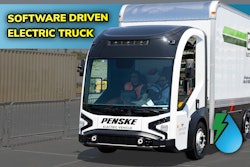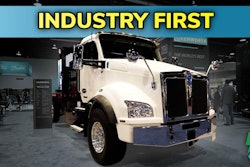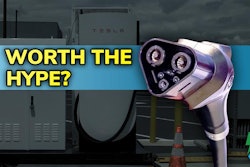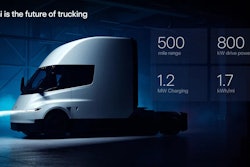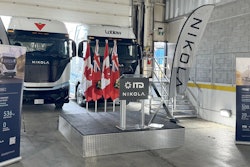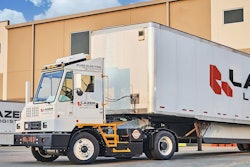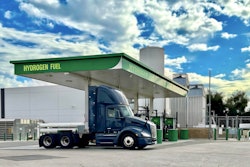With the U.S. grid under increasing strain from EVs, data centers, and industrial applications, many trucking fleets face long delays—sometimes years—before they can access the electricity needed to electrify. Hyliion believes it has a solution: on-site power generation with its Karno Power Module, an example of which was on display at this year's ACT Expo in Anaheim, California.
The Karno is a 200-kilowatt, fuel-agnostic power generator based on Stirling engine technology first developed in 1816, and is now reimagined by Hyliion for modern applications. Unlike traditional diesel generators, the Karno doesn't require oil changes or complex aftertreatment systems. It delivers dramatically lower emissions and can run on over 20 different fuels, including natural gas, hydrogen, and even dimethyl ether (DME).
For fleet operators, the key question is cost: Is generating electricity on-site cheaper than buying from the grid? According to Hyliion, in most cases, yes. The Karno can help fleets avoid high peak demand charges and offer more predictable energy costs. For larger needs, Hyliion is also developing a two-megawatt version of the Karno.
This isn’t just theoretical technology. The U.S. Navy has invested millions in the Karno for potential use in future autonomous sea vessels, and Hyliion is already delivering units to early adopters—including Fortune 200 companies.
As fleets look for practical, scalable paths to electrification, on-site power generation may become a critical piece of the puzzle—and the Karno could help solve it. What's more, it already qualifies for a 30% tax credit under the One Big Beautiful Bill act.
00;00;00;07 - 00;00;20;05
Jay Traugott
Ten electric semis. Charging it once can pull as much power as a Super Bowl. For fleet operators aiming to go electric. That kind of demand can have your utility provider either laughing you out of the room or telling you it'll take a decade to get you the power you need. But what if, instead of relying on utilities, you could generate that power on site?
00;00;20;12 - 00;00;49;00
Jay Traugott
That's the future Helion envisions with its Kano Power module, a fuel agnostic generator that's low maintenance, cost effective, and designed to meet the growing energy demands of transportation. But is this really a practical solution for fleets? Before we go any further. If you're enjoying clean trucking news and videos, you can get more delivered straight to your inbox. Sign up for our free weekly newsletter using the link in the description below.
00;00;49;02 - 00;01;10;23
Thomas Healy
Energy demand electricity demand is skyrocketing. It's increasing. Whether you think of it from an EV standpoint or data centers like. One of the things I shared was ten semi trucks. Being plugged in is equivalent to the entire Super Bowl stadium's electricity consumption. You would have to times that by 100, or would be 1000 vehicles for to equal the amount of power a data center consumes.
00;01;10;25 - 00;01;33;17
Thomas Healy
So the grid is going to be overtaxed, whether it's from EVs or data centers or industrial applications. And the model has been where you have this, the main power plant, and it feeds electricity out to all the end destinations. We think it's a better move going forward to deploy modular power plant systems at that end location and then not be reliant on a main power plant.
00;01;33;23 - 00;01;56;19
Jay Traugott
Highly on vision for a decentralized power grid is not new. For years, companies and governments have been exploring what's known as the micro Grid, a small local power network that can make and use its own electricity. The United States Department of Energy states that by 2035, microgrids are envisioned to be essential building blocks of the future electricity delivery system.
00;01;56;22 - 00;02;21;16
Thomas Healy
We're now getting to a point where you actually can have a local power plant that's just as efficient and performs as well as a major power plant. The way I like to think about it is just like facilities today have an air conditioning unit outside. We see the future as facilities or EV charging sites will also have a box that's sitting there producing electricity, and you're going to make your own power in the long run.
00;02;21;18 - 00;02;36;20
Jay Traugott
So how does the Kano actually work and how does it fit into this decentralized power vision? At its core, it's a linear heat generator built on Stirling engine principles, a technology first developed in 1816 by inventor Robert Stirling.
00;02;36;27 - 00;03;00;07
Thomas Healy
So you go back 200 years ago, you had steam engines, diesel engines. You also had heat engines or what were called Stirling's. And the whole concept there is you have a trapped gas, you heat that gas up. And when you do that it expands. You know, gas gets hot, it expands, and you use that expansion to push a piston one way, and then you do the opposite reaction on the other side to push it back.
00;03;00;07 - 00;03;12;16
Thomas Healy
And so that creates a linear back and forth motion. It's happening about 20 times a second. And then we have a linear motor in the middle that's sitting there producing electricity. As the gensets running.
00;03;12;19 - 00;03;20;28
Jay Traugott
This high pressure gas inside the car now doesn't just drive a piston. It also enables a low maintenance design using gas bearings.
00;03;21;05 - 00;03;41;05
Thomas Healy
There's no oils. There's no lubricants in this. So think of like your car engine. You need to do oil changes that doesn't exist with this system. There's only one moving part per each one of these shafts. And even that moving part glides on gas bearings or air bearings. So think of like an air hockey table. The puck doesn't touch the table.
00;03;41;05 - 00;03;52;08
Thomas Healy
Well that's the same thing that's happening inside this shaft. That actual centerpiece the one moving part is hovering which allows us to get much, much longer intervals in between needing maintenance.
00;03;52;13 - 00;03;57;21
Jay Traugott
The Kano Stirling architecture also allows it to be what Highland calls fuel agnostic.
00;03;57;21 - 00;04;27;05
Thomas Healy
So since our fuel source is heat, we can get that heat from reacting. Natural gas, propane, diesel, hydrogen. So this system is actually designed to be able to operate on up to or over potentially 20 fuels. And those that include some of the ones I mentioned, even some rare ones like ammonia die methyl ether. And so the whole reason why it's able to run on that wide of a spectrum of fuels is because all we're doing is making heat, and then that heat is actually what produces the electricity.
00;04;27;10 - 00;04;52;26
Thomas Healy
So as we think about like, what's the future of the energy landscape, I don't think any of us could predict is it going to be hydrogen? Will it be natural gas. It will be some fuel like ammonia, methanol. Right. We don't know what the future is going to hold. So we see this as a way to almost future proof yourself where you can adopt a solution today that can run on many of the fuels that are expected to be utilized down the road.
00;04;52;28 - 00;05;11;00
Jay Traugott
This version of Highlands Kano has a 200 kilowatt power output using a charger of equivalent power. This could charge a class 5 or 6 electric truck in about one and a half to two hours. But how does the power output and size of the car know compared to a typical diesel generator?
00;05;11;02 - 00;05;33;02
Thomas Healy
So as you compare it to internal combustion engines, we're sitting at about half to maybe a third of the size for the same power output. We're also working on a variant that's a two megawatt variant, which think of the size of a 20ft shipping container. We're able to pack in, two megawatts, where the power into that box.
00;05;33;04 - 00;05;44;07
Jay Traugott
Anyone familiar with commercial diesel engines or generators knows they come with costly maintenance, heavy after treatment systems. However, the cargo avoids that challenge entirely.
00;05;44;12 - 00;05;59;12
Thomas Healy
Due to the way the system works. You actually don't need an after treatment system at all on this, and we're able to achieve NOx and Co levels that are greater than 95% lower than the emissions that come out of a standard reciprocating engine.
00;05;59;15 - 00;06;08;23
Jay Traugott
But beyond emissions, the bigger question for fleet operators is this can generating your own electricity be cheaper than buying it from the grid?
00;06;08;27 - 00;06;29;18
Thomas Healy
And what we've found is because it has that high efficiency on many instances, almost all we can actually produce electricity for cheaper out of this box. Then you can source electricity from the grid. So now as you think about your EV charging site, where you're often getting hit with peak spikes for charging rates, you no longer have that when you're sitting here making your own electricity.
00;06;29;24 - 00;06;41;27
Jay Traugott
Additionally, highly on recently announced that our Kano Power Module qualifies for a 30% tax credit under the One Big Beautiful Bill act.
00;06;41;29 - 00;06;49;17
Jay Traugott
Leon has laid out a compelling vision for the Kano generator. But who's actually using it? And in what? Real world applications?
00;06;49;20 - 00;07;08;12
Thomas Healy
So the Navy is actually helping fund the development of this. They've selected it as a power plant of choice for future autonomous navy vessels. In terms of other customers, this year, we're deploying with our early adopter fleets. We haven't announced who they are, but there's a couple of large fortune 200 companies in that.
00;07;08;14 - 00;07;19;04
Jay Traugott
So what do you think of Highlands Kano generator? Would you use it to electrify your fleet? Let us know in the comments below. And for more videos like this, watch the playlist on the screen now.

